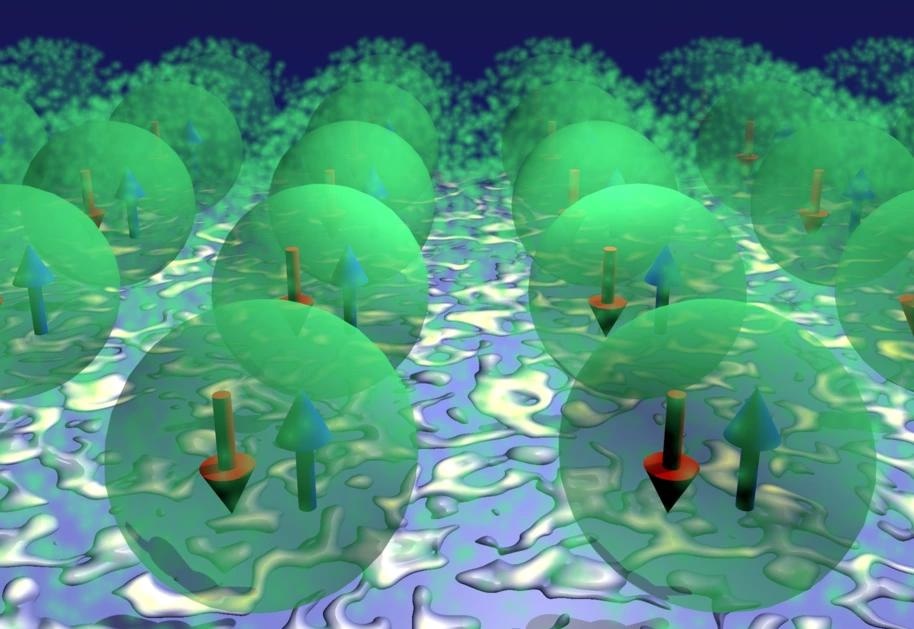Triplons are extremely difficult to image experimentally, and even when attempting to image them, researchers often observe macroscopic materials where measurements are averaged out across the entire sample.
 Artistic illustration depicts magnetic excitations of cobalt-phthalocyanine molecules, where entangled electrons propagate into triplons. Image Credit: Jose Lado/Aalto University
Artistic illustration depicts magnetic excitations of cobalt-phthalocyanine molecules, where entangled electrons propagate into triplons. Image Credit: Jose Lado/Aalto University
Designer quantum materials have a distinct benefit in this regard, according to Academy Research Fellow Robert Drost, the first author of a study published in Physical Review Letters on August 22nd, 2023. These designer quantum materials enable researchers to produce phenomena not seen in natural compounds, allowing them to realize unusual quantum excitations.
These materials are very complex. They give you very exciting physics, but the most exotic ones are also challenging to find and study. So, we are trying a different approach here by building an artificial material using individual components.
Peter Liljeroth, Professor and Head, Atomic Scale Physics Research Group, Aalto University
At the microscopic level, electron interactions regulate quantum materials. These electronic correlations cause unique phenomena, such as high-temperature superconductivity or complex magnetic states, whereas quantum correlations create new electronic states.
The singlet and triplet states are the two entangled states for two electrons. The electron system can be excited from the singlet state to the triplet state by providing it with energy. In some circumstances, this excitation can move through a substance as a triplon, an entanglement wave. Since these excitations are absent from normal magnetic materials, quantifying them in quantum materials has remained a difficult task.
The Team’s Triplon Experiments
The group produced an artificial quantum material with peculiar magnetic characteristics in the latest study using tiny organic molecules. Two frontier electrons are present in each of the cobalt-phthalocyanine molecules employed in the experiment.
Using very simple molecular building blocks, we are able to engineer and probe this complex quantum magnet in a way that has never been done before, revealing phenomena not found in its independent parts. While magnetic excitations in isolated atoms have long been observed using scanning tunnelling spectroscopy, it has never been accomplished with propagating triplons.
Robert Drost, Study First Author and Academy Research Fellow, Aalto University
He added, “We use these molecules to bundle electrons together, we pack them into a tight space and force them to interact. Looking into such a molecule from the outside, we will see the joint physics of both electrons. Because our fundamental building block now contains two electrons, rather than one, we see a very different kind of physics.”
The group observed magnetic excitations in cobalt-phthalocyanine molecules individually first and then in bigger formations like molecular chains and islands. The researchers want to comprehend emergent behavior in quantum materials by starting with the extremely simple and moving toward greater complexity.
The team’s ability to show that the singlet-triplet excitations of its building blocks can move across molecular networks as unusual magnetic quasiparticles known as triplons is what allowed them to publish their study.
We show that we can create an exotic quantum magnetic excitation in an artificial material. This strategy shows that we can rationally design material platforms that open up new possibilities in quantum technologies.
Jose Lado, Study Co-Author and Assistant Professor, Aalto University
The group wants to develop its strategy using more intricate building pieces to create other rare magnetic excitations and ordering in quantum materials. In addition to establishing new platforms for designer quantum materials, rational design from basic components will aid in understanding the complex physics of correlated electron systems.
Journal Reference:
Drost, R., et al. (2023) Real-Space Imaging of Triplon Excitations in Engineered Quantum Magnets. Physical Review Letters. doi:10.1103/PhysRevLett.131.086701